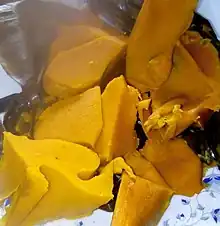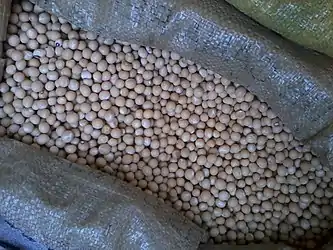Okpa
Okpa (pronounced Ọkpa) is a dish prepared by the Igbo people with a type of beans known as Bambara nuts.[1][2][3] It is common in Enugu state and classified as a traditional Nigerian delicacy. It is not exclusively eaten by the Igbo; other ethnic groups often eat it (with pap or by itself), and it may be that this is most-common (outside Igboland) in Niger State.[4][5] Other Igbo names for okpa include ịgba and ntucha. In Hausa, it is known as gurjiya or kwaruru.[6]


The main ingredients in okpa are Bambara nut flour, pepper, palm oil and (a modest amount of) seasoning. [7][8] Nutritionally, okpa has approximately 16.92% crude protein, 4.93% fat, 26.62% carbohydrate and 216.28 kcal energy value,[9] making it one of the most balanced staples.[10]
Gallery
See also
References
- "Nigerian Okpa –How to make Okpa Food". besthomediet. 2020-09-07. Retrieved 2022-05-21.
- Chinedu, Saint (2022-01-06). "Reasons Why Your Diet Needs Bambara Nut Pudding (Okpa)". Retrieved 2022-05-21.
- Lete, Nky Lily (2013-07-12). "Okpa : How to make Okpa". Nigerian Food TV. Retrieved 2022-05-21.
- "Nigerian Okpa, Okpa di Oku, Okpa Wawa". All Nigerian Recipes. Retrieved 2022-05-21.
- admin. "Nigerian Cuisine: Okpa; How to make Okpa". C.Hubmagazine. Retrieved 2022-05-21.
- "OKPA". The Pretend Chef. 2016-07-05. Retrieved 2022-06-09.
- OrientDailyNews (2017-08-25). "Okpa". Orient Daily News. Retrieved 2022-05-21.
- "Moi Moi (Moin Moin)". My Active Kitchen. 2015-05-25. Retrieved 2022-05-21.
- Adumanya, Obi-Adumanya, and Nwachukwu (2012). "The proximate analysis and sensory evaluation of "Okpa" prepared with fluted pumpkin and scent leaves" (PDF). Canadian Journal on Scientific and Industrial Research. 3 (4): 175–178 – via Google scholar.
{{cite journal}}: CS1 maint: multiple names: authors list (link) - Nwadi, Oluchukwu M.M.; Uchegbu, Nneka; Oyeyinka, Samson A. (March 2020). "Enrichment of food blends with bambara groundnut flour: Past, present, and future trends". Legume Science. 2 (1). doi:10.1002/leg3.25. ISSN 2639-6181. S2CID 213011345.



.jpg.webp)